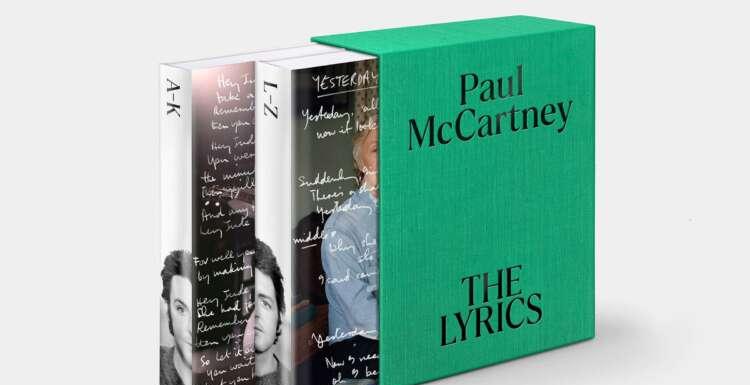The Surging News reporter Qian Lianshui
Paul McCartney had no diary habits and had no intention of autobiography. But he did have a habit of recording his life — writing lyrics. The newly published two-volume book, The Lyrics: 1956 to the Present, contains 154 Lyrics from McCartney and is an important part of the Beatles' life.

《The Lyrics: 1956 to the Present》
The baby-faced McCartney can write lyrics anywhere. From lovers to climate change, race issues, a dog or a car, anything can turn into lyrics. The book is divided into two parts: the alphabetical lyrics themselves, and the words he distilled from five years and 24 formal conversations with the poet Paul Muldoon. The two meet in New York, each lasting about 2-3 hours, enough to discuss 6-8 lyrics.
F开头都是坚实的歌,《Fixing a Hole》《The Fool on the Hill》《For No One》《From Me to You》。 “I”系列包含完整的自己,《I Saw Her Standing There》《I Wanna Be Your Man》《I Want to Hold Your Hand》《I'm Down》 《I'll Follow the Sun》。
The two Pauls were nine years apart in age and two days apart in birthdays. Protracted conversation produces rare fruit. In the book, each song lyric is accompanied by a Malden comment. If Malden had pointed out to McCartney that She Loves You had the shadow of the novel The Go-Between (L.P. Hartley), he would have happily admitted that it had indeed been influenced by it. He would let himself wander back to his childhood in Liverpool: a small indirect phone call under the stairs, being sent out into the street by his dad to collect cow dung and plant roses, watching Bootsie and Snudge (a comedy by Marty Feldman)...
Paul McCartney at home in 2020, filmed by daughter Mary McCartney
Born in 1942 to an Irish immigrant family, Paul McCartney was the first generation to benefit from the Butler Education Act enacted by the British government in 1944 and was the descendant of a new generation of immigrants who escaped the influence of Irish small societies after the war and embraced the new prosperity of England. McCartney's parents did everything they could to get the best education possible for the two boys in the family. The father, who was a cotton salesman, was sensitive to words, obsessed with scrabble, and passed on this enthusiasm to his son. Wheat Cattney also loves to find difficult words and enjoys the thrill of blood clotting when finding it. He is as interested in the themes of masks and personalities as Yeats, "everything always starts from me, the various characters that appear in the song are fictional, and the key is the imagination of the characters."
An English teacher who graduated from Downing College, Oxford, opened the door to literature for him and was the most important mentor of McCartney's student days. The other mentors are various pop music and radio shows. Little Richard and Chuck Berry, "Brill Building" and "Tin Pan Alley." His earliest idol was Buddy Holly, who "wrote his own songs and sang his own songs, and played his guitars himself."
He certainly admired his creative partner, John Lennon. They are left-handed and right-handed, "like looking in the mirror" when they face the piano. They are always like two lower school students, endlessly searching for subjects that have not yet been written into the song, talking childish nonsense and humming lullaby-like simple tones. They talk about their contemporaries, who still write songs with Little Richard jr. and Fred Astire as anchors. "If it were them, what would the song look like?"
Paul McCartney and John Lennon wrote I Saw Her Standing There, Liverpool, 1962. Photo by Mike McCartney
"Sgt. Pepper's Lonely Hearts Club Band Pepper's Lonely Hearts Club Band is a big radio show. The radio show greatly satisfied McCartney's interest in "word puzzles, clue puzzles, finding the most appropriate word to describe a scene." Dylan Thomas's final masterpiece, Under Milk Tree, and many of the excellent radio dramas of the time nourished his imagination. McCartney treated himself as a playwright, writing a miniseries he could sing and carving tiny faces for ant-like characters.
The other two sources of influence are visually related. McCartney painted and painted hundreds of oil paintings. He also likes movies, "My lens is always looking around, looking for clues of inspiration from life." ”
Using a song as a movie script can help you enter the world of Eleanor Rigby. The song, published in 1966, is one of McCartney's most famous works, featuring a cinematic structure. The two protagonists appear in the first and second stanzas, and in the third they converge, as Hitchcock does in the Bathroom Blood/Water scene in Horrors (1960). Like Horror, Eleanor Rigby hides themes of loneliness and death.
"Paul McCartney's greatness comes from his humility. He is what Roland Barthes calls the 'death of the author', allowing different people to constantly reinvent his work by listening and reading. "What Malden admires most is his selflessness and selflessness." He writes continuously, and with just a pencil, a piece of paper, and a guitar, the timeless work will come to the world on its own. ”
"Hey Jude" handwritten lyrics
Editor-in-Charge: Chen Shihuai
Proofreader: Liu Wei